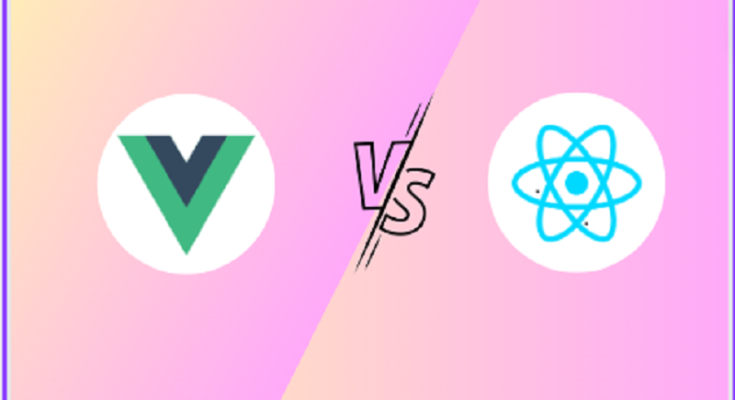In 2023, developers are faced with a difficult decision: Vue vs React. Both have their own benefits and drawbacks, and both can help developers create a wide range of applications. But which one is the best choice for your project in 2023? In this blog post, we’ll be exploring the differences between Vue and React to help you make an informed decision about the best framework for your project in 2023. We’ll discuss the pros and cons of each, as well as the latest features and updates that have been released in the past year.
React.js Vs Vue.js: Understanding the Basic
When it comes to JavaScript frameworks, two of the most popular ones are React.js and Vue.js. While both are widely used by developers for creating high-performance and dynamic web applications, they have their own set of differences that make them unique.
React.js was created by Facebook in 2011 and has since become one of the most popular frameworks among developers. Vue.js, on the other hand, was developed by Evan You in 2014 and has rapidly gained popularity among developers due to its simplicity and ease of use.
React.js is known for its scalability and ability to handle complex projects. It allows developers to build large-scale applications with a modular approach, making it easy to manage and scale as the project grows. Vue.js, on the other hand, is known for its simplicity and flexibility, allowing developers to quickly build applications with ease.
Both frameworks have their own set of strengths and weaknesses. While React.js is great for large-scale applications, it requires a steeper learning curve and may not be the best choice for smaller projects. Vue.js, on the other hand, may not be as scalable as React.js, but it is more lightweight and easy to pick up for new developers.
So, when it comes to choosing between React.js and Vue.js, it ultimately depends on your project requirements and the expertise of your development team. If you’re looking to hire Vue.js developers for a small to medium-sized project, then Vue.js might be a better fit.
Comparison of Vue and React in Terms of Performance
When it comes to the performance of Vue and React, both frameworks have their unique strengths and weaknesses. Let’s take a closer look at how they compare in terms of performance.
Vue.js is known for its fast rendering speed due to its reactive system, which allows for faster updates to the UI. Additionally, Vue.js provides built-in optimizations such as lazy loading of components and async rendering, which helps to reduce the time it takes for a user to interact with the application. However, when it comes to handling large and complex applications, Vue.js can struggle due to its smaller community and lack of support for server-side rendering.
On the other hand, React.js is also known for its fast rendering speed, thanks to its virtual DOM and ability to efficiently update only the necessary parts of the UI. React.js is also widely used in the industry, which means that there are plenty of resources and tools available for developers. However, its reliance on a large number of third-party libraries and components can sometimes lead to a slower application speed.
When it comes to choosing between Vue.js and React.js, it ultimately comes down to the specific needs and requirements of the project. If performance is the primary concern and the application is not expected to grow to a massive scale, then Vue.js could be a better option. However, if the project is expected to grow and evolve over time, React.js with its strong industry support and massive ecosystem of libraries and components could be a better fit.
If you’re looking to hire React.js developers, make sure to evaluate their experience and skills based on your specific project requirements.
Vue Vs React: What Are the Similarities Between Them?
While Vue and React may have their differences, they also share a lot of similarities. Here are some key similarities between the two frameworks:
1. Both are JavaScript frameworks used for building user interfaces.
2. Both use a virtual DOM, which makes updates more efficient.
3. Both have a component-based architecture, which allows for code reuse and modularity.
4. Both have a large and active community, which means plenty of resources and support are available.
5. Both can be used for server-side rendering and building mobile apps.
Vue Vs React: Pros and Cons
When it comes to choosing between Vue and React, it’s important to consider the pros and cons of each framework. Let’s take a closer look at some of the benefits and drawbacks of both Vue and React.
Pros of Vue:
1. Simplicity: Vue’s syntax and structure make it easy to understand and learn, even for beginners.
2. Flexibility: Vue allows you to create reusable components, making it easy to build complex applications.
3. Performance: Vue is known for its fast rendering speed and small bundle size.
4. Good documentation: Vue has comprehensive and user-friendly documentation, making it easy to troubleshoot issues.
5. Developer experience: Vue’s focus on developer experience means that it has a strong community with plenty of resources and tools available.
Cons of Vue:
1. Limited adoption: Although Vue has been gaining popularity in recent years, it still has a smaller community compared to React.
2. Limited plugins and libraries: Because of its smaller community, there may be limited resources and tools available for Vue.
3. Over-simplification: Some developers criticize Vue for being too simple, which can limit its flexibility in complex applications.
Pros of React:
1. Popularity: React has a massive community and is widely used by developers all over the world.
2. Performance: React’s virtual DOM allows it to quickly render changes without having to update the entire page.
3. Reusable components: React’s component-based structure allows developers to create reusable UI components.
4. Flexibility: React’s flexibility allows it to work with a variety of frameworks and libraries.
5. Strong debugging tools: React’s powerful debugging tools make it easy to troubleshoot issues.
Cons of React:
1. Steep learning curve: React’s complex syntax and structure can be difficult for beginners to learn.
2. JSX can be confusing: Some developers find JSX, React’s markup language, to be confusing and difficult to use.
3. Large bundle size: React’s bundle size can be larger compared to other frameworks, which can impact performance.
4. State management can be tricky: Managing state in React can be challenging, especially in larger applications.
Overall, both Vue and React have their strengths and weaknesses, and the choice between the two will depend on your specific project requirements. Take the time to carefully consider each framework’s pros and cons before making a decision.
Also Read: Is AWS Lambda the Right Choice for Enterprise Software Development?
Future trends and predictions for Vue and React
In 2023, it is likely that Vue and React will continue to dominate the front-end development landscape. Both frameworks are constantly evolving, with new features and improvements being added regularly.
One trend that we can expect to see in both Vue and React is a focus on performance optimization. As web applications become increasingly complex, it is important for these frameworks to offer efficient rendering and state management.
In terms of popularity, React is currently more widely used than Vue. However, Vue has been gaining popularity steadily and may continue to do so in the coming years. Its ease of use and flexibility make it a popular choice among developers who are looking for a lightweight alternative to React.
Another trend that we may see is an increase in the use of TypeScript with both Vue and React. TypeScript offers static typing and other benefits that can improve the quality of code and reduce the likelihood of errors. Read blog: Typescript vs Javascript.




